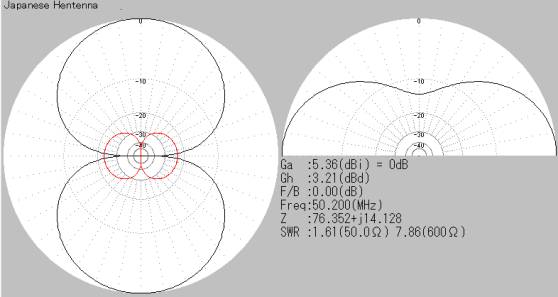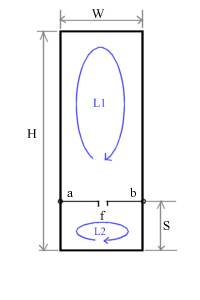怪天线“Hentenna”的来历及相关参数——BI4JUR原创翻译
下文为BI4JUR原创翻译,若转载请说明出处,谢谢!
最近一直看到七公老师在玩怪天线,今天晚上无意之中搜索到了这个天线的来历及参数,和大家一起分享一下。首先贴出国外网站的链接方便大家查看的吧,下面就是链接
http://homepage3.nifty.com/lzk/ANT3.html#HentennaTop然后我在下面这里将英文翻译一下,如有问题欢迎批评指正
"Hentenna" was developed by Japanese 6m Hams (JE1DEU/ JH1FCZ/ JH1YST members) in 1970s.
Hentenna 是由日本的6米爱好者JE1DEU / JH1FCZ/ JH1YST 等人在20世纪70年代发明的
I got more than 400 hits using keyword by "Hentenna" on Japanese search engine, but, not many Hentenna information is available in English. I am very happy if we could share the good antenna with many people on the web.
我曾经在日本的搜索引起中搜索到不下400个关于怪天线的关键字,但是却没有太多关于怪天线的英文介绍,我很高兴如果我们可以将这一个好天线在网络上分享给更多的人。
Finally they got new antenna with good performance, however, it was difficult to explain why the performance is so good, or how it work basically at that time, besides there are many unusual properties. So they named it Hentenna, because, "Hen" means "strange" in Japanese.
最终他们获得了这个新天线的良好表现,但是 这非常难解释为什么这个天线有如此好的表现,在那个年代也不知道它的工作基本原理,却有着非常不同寻常的性能 所以他们将他命名为“Hentenna”, hen 在日语中的意思就是怪。
Anyway, the antenna has good performance and many advantages, it was becoming very popular in Japan. Many of JA stations make it and enjoy their Ham life at Home or in a field. Some Japanese 6m beacon stations are using Hentenna based antenna actually.
不管怎样,这个天线有着优越的表现和优点,它在日本变的非常流行。很多日本的操作者都制作这个天线,并在家里和田地里享受着这天线。日本的6米信标就是使用这个天线作为基本天线的
I got more than 400 hits using keyword by "Hentenna" on Japanese search engine, but, not many Hentenna information is available in English. I am very happy if we could share the good antenna with many people on the web.
我曾经在日本的搜索引擎中找到不下400条关于hentena的关键词,但是关于hentenna的英语信息却不多,我很高兴可以在网络中分享这一个非常优越的天线
1. Easy to make
1、制作简单
- It is possible to adjust impedance and SWR perfectly, This means, not so sensitive to make.
- 完美调节阻抗和驻波是很容易的,那意味着并不需要太高的能力就可以制作
- No special parts are required. You can use any electric conductor for making the main rectangle
- 不需要任何特殊原件。你可以使用任何导电体来制作主矩形阵子
- Easy adjustment
-
调节简单
2. Easy to build up - 2、架设方便
- If you use thin aluminum pipe and thin wire, you can make this antenna for 6m less than 500g
- 如果你使用薄铝管和细导线,你可以做一个小于500g的6米怪天线
- This means, it is easy to put it higher position in the air. You can also use light mast for it.
- 这意味着,这很容易将它架设到高空。你也可以使用轻便的支撑杆。
- As this vertically long antenna, it is easy to install the antenna on a veranda or small space.
- 作为垂直长天线,可以很方便的将这个天线架设在走廊或者很狭小的地方。
- Vertical long physically but mainly Horizontal radiation: This is one of the reason this antenna is "Hen".
- 垂直长矩形主要具有水平方向的辐射,这就是它称之为怪天线的原因之一
3. Good performance
3、优越的表现
* Total performance is equivalent to 2-3 element Yagi-uda antenna,
- Low angle radiation
- 低辐射角度
- 3-3.5 dBd gain
- 3-3.5dBd的增益
表现相当于2-3单元的八木天线
- Wide band width
- 宽带宽

How to make Hentenna如何制作 Hentenna
 |
|
||||||||||||
|
Hentenna Basics Hentenna 基本原理 1. Basically 1 WL Loop antenna 1、基于1个波长的环形天线2. L1 works as 1 loop antenna 2、L1工作为1波长的环形天线 3. L2 works as matching section 3、L2工作为匹配单元 4. Vertical long rectangle make more gain than ordinal square loop and less impedance. L2 helps the matching and low angle radiation. 4、垂直的长方矩形比普通的长方环形获得更高的增益更小的阻抗。L2帮助匹配并且减低了辐射角度 5. 3D pattern is like shell of peanut 5、3D建模图形像花生壳(8字) |
How to Adjust 如何调节 1. Move "a" and "b" point to adjust 1、移动a和b点的位置来调节 S1 >S Matching Frequency UP S1>S 匹配的频率升高 S1 2. Even matching point is fixed, SWR may higher than 1:1.5, Try to move points "a": S1 + little / "b": S1 - little to find best position for SWR . 即便频率匹配了,可能swb仍然高于1.5,试着移动a点,向上增加,或者b点适当减小,来找到驻波最理想的点 (This action makes balancer into hentenna !) (这个地方如果加入巴伦可能会更好) * S1: Adjusted "S" Length S1:调节S的长度 |
6m Hentenna parts example 6m波的配件举例
| 1. Horizontal element 水平单元 |
12mm diameter Aluminum pipe 1000mm x 2 12mm直径铝管1米*2根 |
| 2. Vertical element 垂直单元 |
2mm diameter Stainless steel wire 3000mm x2 2mm直径不锈钢丝 3米*2根 |
| 3. Feeding element 馈电单元 |
2mm diameter Copper wire 480 mm x2 2mm直径铜导线 0.48m*2根 |
|
4. Bite clip for "a" and "b" points 夹具使用在a和b点 |
To make adjustment easier 调节简单的原件 |
Assembly work 组装工作
Make rectangular using parts 1, 2 and appropriate bolts, press connection terminals.
使用1、2项材料制作一个矩形,使用适当的螺丝和接线端子固定牢固
Make feeder elements using 3 and 4 and coax cable.
馈电点使用3、4项材料和馈线
(You can use coax connector at "F" point) (你可以在F点使用馈线连接器)
Adjust Frequency and impedance moving point "a" and "b"
移动a和b点来调节频率及阻抗
Remarks : You may use electric conduct materials for the antenna mast, as far as connecting center of horizontal elements. There is no problem to use none electric conduct mast, like FRP, or using isolator for the joint points.
备注:你可以使用导电材料来制作天线支撑杆,只要链接中心点是与支撑杆绝缘的。当然使用绝缘材料的支撑更更好,如FRP(玻璃钢)。
上面关于怪天线的来历、性能、优点、制作方法、调节方法 就都已经介绍翻译完毕了,下面贴上一个七公完成的怪天线图大家参考欣赏
How to make it .. ( for your refference. )
Close-up pitures :
|
(1) Feeding point (Need water protection! and this is sortterm use. It is beter to replace coax cable to more hevy-duty one. It is better to have a 1:1 balan to convert balanced-unbalanced conversion and it helps SWR issues) 
|
(2) T-Junction (Sliding capability to adjust) Using two Solder-less terminal with a set of 3mm bolt & nut (It's easy for "S" adjustment) 
|
|
(3) Pipe-pipe connection R-Pin (for field operation only) For long term use, need to use stenless bolt instaed. 
|
(4) Pipe-Wire connection Using self-tapping bolt 
|
- 上一篇:3单元的6米波“Hentenna怪天线”及HF天线参数 2015/7/12
- 下一篇:属于我的6米春天----记6米首通,5瓦功率与DU7/PA0 2015/7/12
